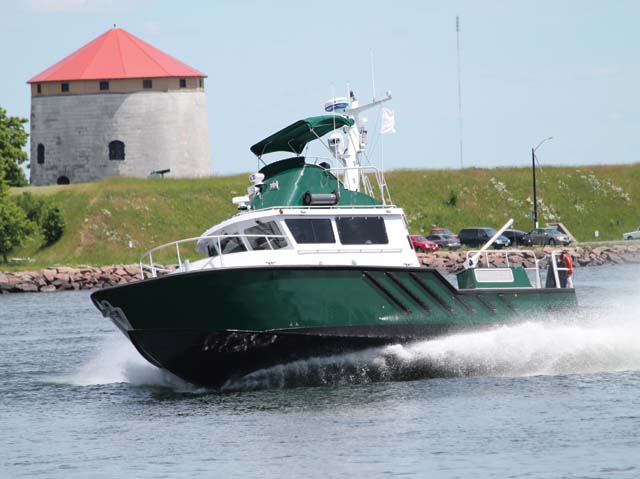In July, MetalCraft Marine delivered a new aluminum 50'8"×15'10" patrol boat, the Thomas Paine, to the Massachusetts Environmental Police for coastal fisheries enforcement. The boat’s design is based on the Sentry patrol boats, which are a joint venture between Kingston, Ontario-based MetalCraft and Brunswick Commercial and Government Products, Edgewater, Fla.,
The most noteworthy feature of the new boat is its fully integrated propulsion system from Volvo Penta. The Thomas Paine is the first commercial vessel in North America with Volvo’s IPS propulsion. First introduced in 2005, the IPS (Inboard Performance System) pod system has been marketed primarily to recreational boaters. Now, with the Thomas Paine and a 64' response boat recently built by Gladding-Hearn for Charleston, S.C., that also features IPS drives [see story, page 48], the innovative, high-tech propulsion system may start gaining a foothold in the U.S. commercial market.
The Thomas Paine has two IPS pods powered by twin 510-hp Volvo Penta D11 marine diesels and IPS650 steerable drive units, also known as pods. Each pod — there can be up to four per boat — has forward-facing, counter-rotating propellers that are always turning in clean water. This more-forward propeller thrust is also said to pull, rather than push, and provides greater efficiency than conventional shaft propulsion.
Ron Huibers, president of Volvo Penta of the Americas, said the IPS drives provide 40% higher cruising range, 20% higher top speed, 30% fuel economy, 30% reduction in CO2 emissions and 50% reduction in noises levels compared with traditional inboard shaft drives.
Bob Clark at MetalCraft is unsure of the exact numbers, but is impressed with the Volvo package. “The thrust is quite remarkable,” he said, “so you don’t have to buy as much horsepower. So if you need less horsepower, you can use smaller engines and smaller tanks, lose weight and gain space.”
You also gain significant performance. “It’s the easiest boat to drive that I’ve ever driven,” said Clark. “I couldn’t get over how easy it was. I’m totally stunned.”
Docking boats with the intuitive joystick takes almost no training, said Clark, and it’s a joy to use. “To swivel the boat, you twist the top of the joystick. You can walk sideways easily, even against a wind. The guys in Boston keep saying how good it is.”
The control package also includes built-in dynamic positioning, which was a selling point for the Massachusetts Environmental Police, along with the fuel economy.
“Because the boat idles a lot on station, the automatic DPS was another critical factor in the decision to go with the Volvo Penta IPS,” said Chris Baker, acting director of the police.
The exhaust system is another plus. With exhaust that is discharged on the backside of the pod under water in the boat’s wake and soft-mounted engines, IPS is quiet and mostly aroma free.
The electronic controls with joystick, the exhaust system, the propellers, everything comes fully integrated from Volvo Penta, which makes installation much easier for the boatbuilder.
It’s also easy to change out a damaged pod. And if broken off, the design prevents flooding in the engine room.
The spacious cabin includes two berths, a head, a galley and storage space. The boat also carries radiation detection equipment and the cabin is pressurized with a Safe Cell CBRN system from American Safe Room.




